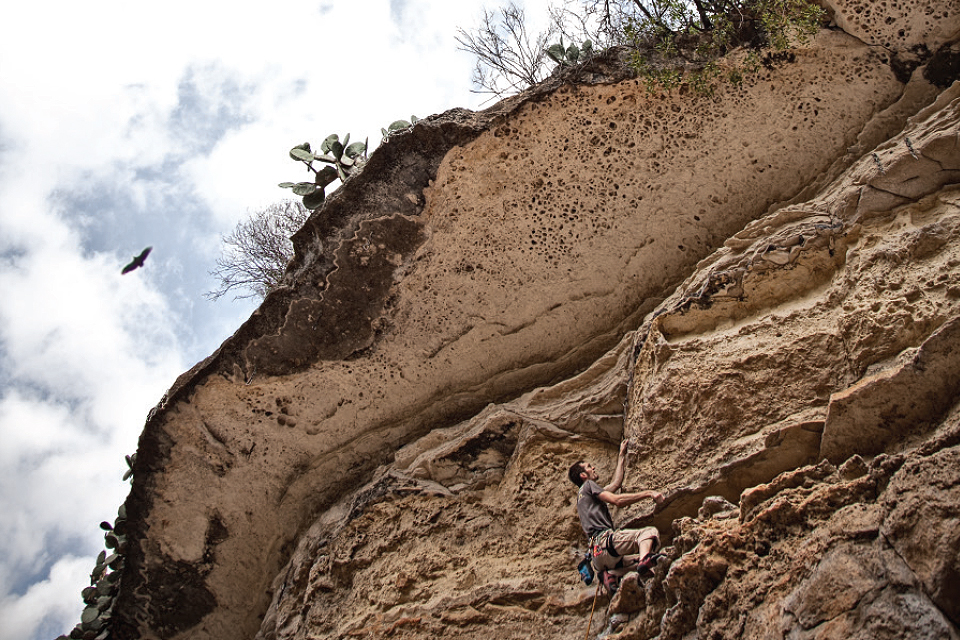Is Rock Climbing for You?

Ben Himes, 30, nodded toward his rock wall at Sharp End Athletics and said, “If the climbing bug bites, it won’t let go.” He should know. During the past ten years, he has climbed in Northern Italy, Southern Germany, Austria, and many locations in the United States. After playing professional baseball, he started coaching sports including batting, pitching, and climbing. The busy gym owner doesn’t climb as much as he would like, but the bug still bites, as the name of his gym shows. The “sharp end” of a lead climber’s rope stays anchored as he climbs above it, risking a fall and stretching his limits. Himes noted that Austin hosts a burgeoning community of climbers: “This is a great place for anyone to get started in the sport.”
Swinging ten feet high in a climbing harness, Tommy Cockerell, 27, instructed his beginners’ class at Austin Rock Gym South with the confidence that over five years experience brings. All of his new students climbed 20 to 30 feet high and got down safely. Cockerell said that you don’t have to be young, fit, and athletic. With proper training, any healthy person can learn to climb, whether you are four years old or well over seventy. Cockerell, who has taught people of all ages and fitness levels, stated simply, “You just have to want to do it.”
Beginner Stephanie Lopez, 26, found her inner climber during the first class of the four-week course she took with Cockerell. She became interested in climbing when she watched several friends climb outdoors. They encouraged her to take an indoor class first. Afterwards, she plans to climb near El Paso, where she grew up.
Caitlin Meredith, 36, also showed prowess by climbing to the top of the 15-foot bouldering wall using only her hands and feet, no ropes. Crash mats on the floor served as back-up safety features while Cockerell and another student held their hands up to offer support if she needed it. She didn’t. Students seldom fall while bouldering, a term for climbing without ropes.
A few minutes later, Cockerell took his class to the 30-foot top rope wall and taught them how to climb using a rope, harness, and belaying techniques. After they mastered the footholds, he introduced the technique of smearing, or walking up the wall on the balls of your feet. Robert Johnson, whose wife gave him climbing lessons as a gift, walked up easily.
Getting Started
To find out whether you, too, have an inner Spider-Man, both Himes and Cockerell agree that the best idea is to start indoors with an experienced climbing instructor at an established gym. The worst idea is to buy ropes, shoes, and climbing harnesses and head out to the Barton Creek greenbelt, Enchanted Rock, or Reimers Ranch alone or with an inexperienced friend or two. Disasters can happen, as anyone who has read the book or seen the movie 127 Hours knows (for those who don’t, the true story involves climber Aron Ralston cutting off his own arm to save his life after a fall while out alone in the canyons of Utah).
Another aspect of getting started is to assess your physical strength. Like rowing, climbing is mainly a lower-body sport; you push yourself up with your legs. You don’t pull much with your arms, though you do need to develop good finger, hand, and forearm strength for gripping. But you don’t have to be Superman before you start. Anyone can develop stronger legs and hands during a climbing class. Both Himes and Cockerell pointed out that women often make excellent climbers because of their leg strength and flexibility.
It’s a little harder to estimate your mental strength. Fear of heights is a common phobia, and discovering how to handle this fear can be one of climbing’s greatest benefits. Cockerell said that over time you can learn to “set aside your fears” by emphasizing safety and trusting your equipment. Himes added that “focusing on just one thing, such as your breathing,” can get you through. When you do find your mental strength in a tight situation, nothing is ever as scary again.
If you’re almost ready to climb but want to read more about it, take a look at Austin Rock, by Sean O’Grady. REI stocks this guide to popular climbing locations near Austin, along with magazines devoted to the sport such as Climbing, Alpinist, and Rock and Ice. These magazines contain spectacular photographs of the international climbing community. Another outdoor book is Learn Rock Climbing in a Weekend by Kevin Walker, which is available at the Austin Public Library.
Climbing Indoors
Austin Rock Gym
South, 4401 Friedrich Lane # 300, (512) 441-2423, and Austin Rock Gym North, 8300 North Lamar Blvd # 102B, (512) 416-9299, present a full range of climbing classes, strength programs, and outdoor sessions when you’re ready. Shoes and chalk bags are available (you may want to buy your own later). Seewww.austinrockgym.com.
Sharp End Athletics
8990 Research Blvd, (512) 695-7376, offers informal bouldering instruction and a European-style wall (no route markers) for practice. Seewww.sharpendathletics.com.
Main Event Entertainment
13301 N. 183, (512) 401-0000, gives no classes but requires only a 10-minute safety orientation and provides a large Vertical Challenge area where you can practice.
See www.maineventusa.com.
Climbing Outdoors
Barton Creek Greenbelt has a convenient entry point near MoPac and Barton Skyway. Milton Reimers Ranch Park is at 23610 Hamilton Road in Dripping Springs. Enchanted Rock State Natural Area is at 16710 Ranch Rd 965 near Fredericksburg. For outdoor classes, contact Austin Rock Gym and guiding companies Rock-About and Mountain Madness.
Be safe! Almost anyone can climb, but climbing isn’t for everyone. If it’s right for you, it won’t take a radioactive insect bite to get your Spidey on.
Jody Kelly, owner of Strengthmobile, is an ACE-certified personal trainer who conducts sessions in the homes of the elderly or disabled. She races triathlons, lifts weights, and takes Pilates mat classes.






